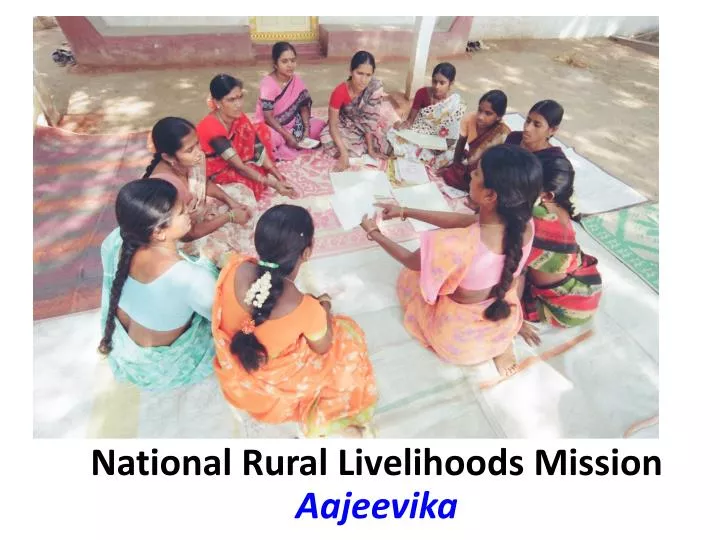
NRLM Latest Updates
- As part of Azadi ka Amrit Mahotsav, a total of 152 Centre for Financial Literacy & Service Delivery (SAKSHAM Centres) across 77 districts of 13 states were launched under Deendayal Antyodaya Yojana – National Rural Livelihoods Mission (DAY-NRLM) of the Ministry of Rural Development during October 4th and 8th, 2021.
- The objective of SAKSHAM Centres is to provide financial literacy & facilitate the delivery of financial services to SHG members and the rural poor.
- Centre for Financial Literacy & Service Delivery (CFL&SD) would act as a one-stop solution/single window system for the basic financial needs of Self-Help Group (SHG) households in rural areas.
- These Centers will be managed by the SHG network, largely at the level of the Cluster Level Federations (CLFs), with the help of trained Community Resource Persons (CRPs)
Deen Dayal Antyodaya Yojana – National Livelihoods Mission (DAY-NRLM)
The DAY-NRLM is essentially a poverty relief programme of the Central government. It was launched as ‘Aajeevika – National Rural Livelihoods Mission (NRLM)’ by the GOI’s Ministry of Rural Development in the year 2011. It was renamed as DAY-NRLM in 2015.
The scheme is an improved version of the earlier Swarnjayanti Gram Swarozgar Yojana (SGSY).
- The programme is supported partially by the World Bank.
- It aims at creating effective and efficient institutional platforms to enable the rural poor to increase their household income by means of sustainable livelihood enhancements and better access to financial services.
- Additionally, the poor would also be enabled to attain improved access to rights, public services, and other entitlements.
- The mission aims at harnessing the inherent capabilities of the poor and equip them with capacities (such as knowledge, information, tools, finance, skills, and collectivization for them to take part in the economy.
- The scheme started with an agenda to cover 7 Crore rural poor households via Self Help Groups (SHGs) and federated institutions and support them for livelihoods collectives in 8-10 years.
- In 2021, the Union Cabinet had approved a special package worth Rs. 520 crore in the Union Territories (UTs) of Jammu and Kashmir (J&K) and Ladakh for a period of five years (till the financial year 2023-24) under the Deendayal Antyodaya Yojana-National Rural Livelihood Mission (DAY-NRLM).
- The decision is in line with the government’s aim to universalise all centrally sponsored beneficiary-oriented schemes in Jammu & Kashmir and Ladakh in a time-bound manner.
Benefits
- One member (preferably a woman) from each rural poor household would be brought under the Self Help Group (SHG) network. Women SHG groups would have bank-linkage arrangements.
- SHGs would be federated at the village level and higher levels to provide space, voice and resources and to reduce dependence on external agencies.
- The Mission consists of four components, viz., (i) social mobilization, community institution, and capacity building; (ii) financial inclusion; (iii) livelihood promotion; and (iv) convergence.
- The participatory social assessment would be organized to identify and rank all households according to vulnerability. The ranking would be with reference to the poorest of the poor, single woman and woman-headed households, disabled, landless, and migrant labor and they would receive special focus.
- Training and capacity building of the poor, particularly in relation to managing the institutions, livelihoods, credit absorption, and creditworthiness.
- The Mission also supports the development of skills for rural youth and their placement, training, and self-employment through rural self-employment institutes (RSETIs), innovations, infrastructure creation, and market support.
- Provision of Revolving Fund as support to SHGs to strengthen their institutional and financial management capacity and build a good credit history.
- Provision of Community Investment Support Fund (CIF) in the intensive blocks to the SHGs through the Federations to advance loans and/or undertake common/collective socio-economic activities.
- Introduction of financial inclusion model, loaning from banks, association and coordination with banking/financial institutions, and coverage from loss of life, health, etc.
- Provision of Interest Subvention on loans availed by SHGs to cover the difference between the lending rate of the banks and 7%.
- Convergence with various ministries and agencies dealing with poverty reduction of rural poor.
- With highly decentralized planning; States will have liberty in developing their own action plan for poverty reduction.
- NRLM to have suitable linkages at the district level with District Rural Development Agencies (DRDAs) and Panchayat Raj Institutions (PRIs).
Eligibility
- SHGs should be in active existence at least for the last 6 months as per the books of account of SHGs and not from the date of opening of the S/B account.
- SHGs should be practicing ‘Panchasutras’ i.e., Regular meetings; Regular savings; Regular inter-loaning; Timely repayment; and Up-to-date books of accounts.
- Qualified as per grading norms fixed by NABARD. As and when the federations of the SHGs come to existence, the grading exercise may be done by the Federations to support the banks.
- The existing defunct SHGs are also eligible for the credit if they are revived and continue to be active for a minimum period of 3 months
Documents Required
- Aadhar Number
- Proof of Identity
- Proof of Residence
- Voter ID Card
- Passport Size Photo
Application Process
FAQs
How Is It Different From Swarna Jyanti Swarozgar Yojana (SGSY)?
NRLM has adopted ‘demand driven’ strategy, in place of SGSY’s ‘allocation based’ strategy. This implies that under NRLM, states have greater autonomy to plan for implementing the programme. NRLM encourages states to prepare State Perspective for Implementation Plans (SPIP) for seven years and Annual Action Plans (AAPs). The allocation for the state is released against the approved AAP. NRLM has adopted a Participatory Identification of Poor (PIP) instead of the BPL to identify its beneficiaries.
How Is NRLM Being Implemented?
NRLM has put in place a dedicated, sensitive support structure to facilitate the creation and functioning of IoP. The SRLMs are given the responsibility of implementing the programme in the states based on their States Perspective Implementation Plans (SPIPs) and Annual Action Plans (AAPs). District Mission Management Units (DMMU) and Block Mission Management Units (BMMU) are established to implement the programme. At the national level, the National Rural Livelihoods Promotion Society (NRLPS) has been set up to serve as the technical support agency to NRLM. NRLPS supports the SRLMs in strategizing, planning and implementing NRLM.
Practice area's of B K Goyal & Co LLP
Income Tax Return Filing | Income Tax Appeal | Income Tax Notice | GST Registration | GST Return Filing | FSSAI Registration | Company Registration | Company Audit | Company Annual Compliance | Income Tax Audit | Nidhi Company Registration| LLP Registration | Accounting in India | NGO Registration | NGO Audit | ESG | BRSR | Private Security Agency | Udyam Registration | Trademark Registration | Copyright Registration | Patent Registration | Import Export Code | Forensic Accounting and Fraud Detection | Section 8 Company | Foreign Company | 80G and 12A Certificate | FCRA Registration |DGGI Cases | Scrutiny Cases | Income Escapement Cases | Search & Seizure | CIT Appeal | ITAT Appeal | Auditors | Internal Audit | Financial Audit | Process Audit | IEC Code | CA Certification | Income Tax Demand Notice | Psara License | FCRA Online
Most read resources
tnreginet |rajssp | jharsewa | picme | pmkisan | webland | bonafide certificate | rent agreement format | tax audit applicability | 7/12 online maharasthra | kerala psc registration | antyodaya saral portal | appointment letter format | GST Search Taxpayer | caro 2020 | Challan 280 | itr intimation password | internal audit applicability | preliminiary expenses | mAadhar | e shram card | ec tamilnadu | aaple sarkar portal | epf activation | scrap business | brsr | depreciation on computer | west bengal land registration | traces portal | Directorate general of GST Intelligence | form 16 | rtps | patta chitta
